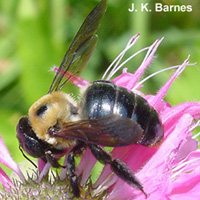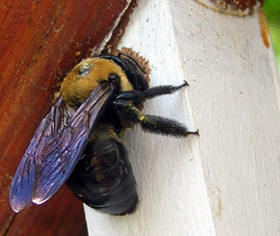|
 Carpenter
bees are large, black and
yellow bees frequently seen
in spring hovering around
the eaves of a house or the
underside of a deck or porch
rail. They are most often
mistaken for bumble bees,
but differ in that they have
a black shiny tail
section.The carpenter bee is
so-called because of its
habit of excavating tunnels
in wood with its strong
jaws. The round half-inch
diameter entrance holes are
usually found on the
underside of a board. A
tell-tale trace of coarse
sawdust is often found on
the surface beneath the
hole. Wooden decks,
overhangs and other exposed
wood on houses are prime
targets. Painted and treated
woods are less preferred,
but they are by no means
immune to attack. Carpenter
bees are large, black and
yellow bees frequently seen
in spring hovering around
the eaves of a house or the
underside of a deck or porch
rail. They are most often
mistaken for bumble bees,
but differ in that they have
a black shiny tail
section.The carpenter bee is
so-called because of its
habit of excavating tunnels
in wood with its strong
jaws. The round half-inch
diameter entrance holes are
usually found on the
underside of a board. A
tell-tale trace of coarse
sawdust is often found on
the surface beneath the
hole. Wooden decks,
overhangs and other exposed
wood on houses are prime
targets. Painted and treated
woods are less preferred,
but they are by no means
immune to attack.
Unpainted or stained cedar,
cypress and redwood shingles
and siding are also attacked
despite their pest-resistant
reputations. Carpenter bees,
like their distant
relatives, the carpenter
ants, differ from termites
in that they do
not consume the wood as
food. They simply excavate
tunnels for nesting sites.
|
|
BIOLOGY
 Carpenter
bees overwinter as adults,
often inside old nest
tunnels. They emerge in
April and May with the males
usually the first to appear.
Males can be distinguished
from females by a whitish
spot on the front of the
face. The males do not have
stingers, but they are
territorial and will harass
other bees and people who
venture near their protected
areas. Females can sting,
but rarely do so unless
confined in your hand or are
highly agitated. They feed
on plant nectar, then begin
constructing new tunnels in
a few weeks. The entrance
holes start upward (or
inward)
for about one-half inch or
more, then turn horizontally
and follow the wood grain.
The galleries typically run
six to seven inches, but may
exceed one foot.
Occasionally, several bees
use the same entrance hole,
but they have individual
galleries branching off of
the main tunnel. If the same
entrance hole is used for
several years, tunnels may
extend several feet in the
wood. Inside her gallery,
the female bee gradually
builds a large pollen ball
which serves as food for her
offspring. She deposits an
egg near this pollen ball
and then seals off this
section of tunnel with a
partition made of chewed
wood. She constructs
additional cells in this
manner until the tunnel is
completely filled, usually
with six to seven cells
(depending on length of the
tunnel). These adult bees
die in a matter of weeks.
The eggs hatch in a few days
and the offspring complete
their development in about 5
to 7 weeks. Adults begin to
emerge in later summer.
Although the bees remain
active, feeding on pollen
the general area, they do
not construct new tunnels,
but may be seen cleaning out
old tunnels which they will
use as overwintering sites
when the weather turns cold. Carpenter
bees overwinter as adults,
often inside old nest
tunnels. They emerge in
April and May with the males
usually the first to appear.
Males can be distinguished
from females by a whitish
spot on the front of the
face. The males do not have
stingers, but they are
territorial and will harass
other bees and people who
venture near their protected
areas. Females can sting,
but rarely do so unless
confined in your hand or are
highly agitated. They feed
on plant nectar, then begin
constructing new tunnels in
a few weeks. The entrance
holes start upward (or
inward)
for about one-half inch or
more, then turn horizontally
and follow the wood grain.
The galleries typically run
six to seven inches, but may
exceed one foot.
Occasionally, several bees
use the same entrance hole,
but they have individual
galleries branching off of
the main tunnel. If the same
entrance hole is used for
several years, tunnels may
extend several feet in the
wood. Inside her gallery,
the female bee gradually
builds a large pollen ball
which serves as food for her
offspring. She deposits an
egg near this pollen ball
and then seals off this
section of tunnel with a
partition made of chewed
wood. She constructs
additional cells in this
manner until the tunnel is
completely filled, usually
with six to seven cells
(depending on length of the
tunnel). These adult bees
die in a matter of weeks.
The eggs hatch in a few days
and the offspring complete
their development in about 5
to 7 weeks. Adults begin to
emerge in later summer.
Although the bees remain
active, feeding on pollen
the general area, they do
not construct new tunnels,
but may be seen cleaning out
old tunnels which they will
use as overwintering sites
when the weather turns cold.
DAMAGE
 Typically,
carpenter bees do not cause
serious structural damage to
wood unless large numbers of
bees are allowed to drill
many tunnels over successive
years. The bees often
eliminate their wastes
before entering the tunnel.
Yellowish-brown staining
from voided fecal matter may
be visible on the wood
beneath the hole as seen in
the picture above.
Woodpeckers may damage
infested wood in search of
bee larvae in the tunnels.
In the case of thin wood,
such as siding, this damage
can be severe. Holes on
exposed surfaces may lead to
damage by wood-decaying
fungi or attack by other
insects, such as
carpenter ants. Typically,
carpenter bees do not cause
serious structural damage to
wood unless large numbers of
bees are allowed to drill
many tunnels over successive
years. The bees often
eliminate their wastes
before entering the tunnel.
Yellowish-brown staining
from voided fecal matter may
be visible on the wood
beneath the hole as seen in
the picture above.
Woodpeckers may damage
infested wood in search of
bee larvae in the tunnels.
In the case of thin wood,
such as siding, this damage
can be severe. Holes on
exposed surfaces may lead to
damage by wood-decaying
fungi or attack by other
insects, such as
carpenter ants.
|
